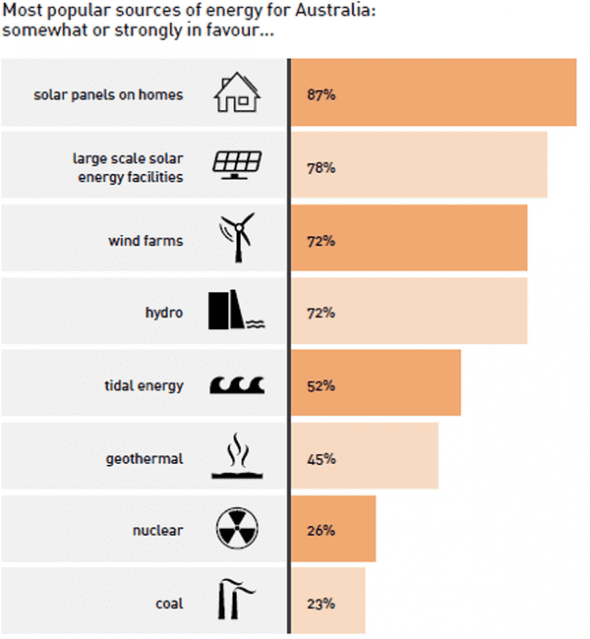 by Giles Parkinson, Renew Economy: http://reneweconomy.com.au/2015/10-things-we-learned-about-tony-abbotts-war-on-renewables-99415
by Giles Parkinson, Renew Economy: http://reneweconomy.com.au/2015/10-things-we-learned-about-tony-abbotts-war-on-renewables-99415Ever since the Coalition election victory in September 2013, and indeed beforehand, RenewEconomy has been accused of making a harsh assessment on its approach to climate and clean energy policies.
Wind energy the biggest loser as Abbott sweeps to power, we wrote the day after this ultra-conservative Coalition came to power.
And we continued with headlines such as Australia’s wind turbine syndrome, why Abbott hates the RET; Abbott’s Achilles Heel - is it ideology or ignorance?: and Tony Abbott’s energy rules: It’s goodies versus baddies.
Harsh? Turns out we were probably not harsh enough. Our lingering suspicion that the Abbott government’s policy positioning and actions have been designed with one thing in mind - to cripple the clean energy industry in Australia - have been proven to be true … by the Prime Minister himself.
On Thursday, as we and many others reported, Abbott not only said that he did not like the look of wind turbines (he thinks they are awful), he believes they may be harmful to human health, and it has always been his government’s intention to stop their roll-out. He would, if he could, dump the RET entirely. He may only be one Senate vote away from being able to do just that.
In saying this, Abbott blew away what little credibility remained of the Coalition’s clean energy policies, contradicting just about everything his government has said about the sector in the lead up to the election, and since.
The tragedy for the wind industry is its problems will be ongoing. Given the precarious nature of the Senate, uncertainty will linger, the sector, international companies in particular, will know its $10 billion investment is not welcome, and Coalition Senators will continue calling for greater regulation from a government that promises to de-regulate.
So, what have we learned from the latest offering from the Abbott government, at the alter of 2GB’s Alan Jones? Here’s 10 things.
The Coalition will kill the RET for good, if it gets the chance
The intentions of the Abbott government are clear: If they could get it past the Senate, they would kill the RET. And the Senate numbers, and the anti-wind rump on the cross-bench, suggest he is just one vote away from being able to do that. Before he became PM, Tony Abbott had praised the RET as an initiative of the Howard government. Knowing what we now know, he told Jones, it was probably not the best way to go. But what exactly is it that he now knows? The impact on coal-fired generation?
The lingering uncertainty could make investment more difficult and expensive
The wind industry has been crippled, not by the lack of legislation, but by the uncertainty surrounding its future. Abbott, the self-titled infrastructure PM, is effectively telling international investors that he is not interested in their $10 billion proposed infrastructure investment. No wonder some of the biggest international financiers, such as Banco Santander, have effectively packed their bags and left. The impact could be felt in risk assessment by banks, and higher costs of finance. That, in turn, will make wind farms more expensive than they need be.
Give Abbott credit, he’s very good at strangling industries he doesn’t like
Whatever else you might say about Abbott’s antipathy to wind farms, he has been devastatingly effective in bringing the industry to a halt. Investment in large-scale renewables in Australia has been virtually zero over the last 18 months, punctuated by only a few projects (Nyngan and Broken Hill solar, plus Moree) supported by institutions that Abbott has tried to repeal, and the 90% renewable energy plan pushed by the ACT government.
Nearly everything the Coalition says about renewables is untrue
As we pointed out in the story Abbott government’s 10 biggest whoppers about renewable energy, the Coalition government has been making stuff up as they go along, including the idea that they are “supporters of renewable energy”. They lied about the commitment to renewables promised by Abbott and his senior ministers before the poll. They made up stuff about the impact on energy prices (disproved by its own review led by climate skeptic and nuclear advocate Dick Warburton), and then about the inability to reach the target, and the likely payment of penalty prices. Contrary to Hunt and Macfarlane’s claim that the revised 33,000GWh target is an increase in renewables, Abbott makes clear it is a cut (from 41,000GWh) and deliberately so.
Abbott is guided by dodgy websites
Last year, Abbott was caught out dog whistling to climate deniers when he described emissions trading as a “so-called market, in the non-delivery of an invisible substance to no-one”, an expression he and/or his advisors borrowed from some dubious websites. Talking with 2GB’s Jones, Abbott constantly referred to the wind turbines he wanted to stop as “these things” (eight times in fact) - an uncanny reference to a particularly venal and nasty website called Stop These Things, which is run by anonymous opponents of the wind industry. The group organised a poorly attended wind farm rally in Canberra last year which was MC’d by Jones, and attended by some Coalition members. Is this really where the Abbott government sources its information? It is certainly not based on personal experience, because he has only ever visited one turbine, a single one on Rottnest Island. Maybe Abbott just relies on the input of his closest advisers, Maurice (global warming is a UN hoax) Newman, and Dick (I’m not a skeptic I just don’t believe the science) Warburton? It’s quite possibly the most misinformed government in Australian history.
Abbott has run these campaigns before
As a former minister of health, you’d expect Abbott to have a greater respect for medical evidence. But Abbott has form. Here is Abbott on mobile phone towers way back in 1985, promising to “change the rules” to prevent Telstra building “these things” wherever the company liked.
Big utilities should be worried
The country’s big utilities have been enthusiastic co-conspirators in Abbott’s campaign against the renewable energy target, but now they might not find his intervention very helpful. The utilities’ contempt for renewables was driven by their desire to protect profits from their fossil fuel investments, as well as their disdain for new technologies. Now, however, they have suddenly realised just what impact rooftop solar, and soon battery storage, will have on their businesses, and the options they present for their customers. Uniquely among industries, these technologies give consumers the ability to tell utilities they no longer want to be a part of their network, or their billing system. That has created an about-face in tactics and strategy where the utilities are trying desperately to be their customers’ best friend, and to prove their green credentials. Abbott’s defence of the interests of big coal is not helpful. The consumers’ beef is not with utilities, in particular, but the abuse of centralised power in general. And now they have the means to act.


Abbott is out of step with the general population
As an enunciated electoral position, it is not entirely clear whether Abbott’s views on wind farms and renewable energy in general are a vote-winner. This poll (right) shows how various forms of energy are received. With 1.4 million households with rooftop solar PV, and two million if solar hot water is included, this is a potential issue at the next poll. The next big movement, though, is not just individual households, but community power. On Thursday 70 people turned up in Lismore for an information session on the first big solar arrays to be jointly funded by the community and a council. It is, says project proponent Adam Blakester, just one of nearly 60 projects in the making, and the precursor for hundreds more. As the graph above illustrates, households and small business (represented in grey) have taken over as the biggest investors in renewable energy.
Abbott still says coal good for humanity
Abbott has a different view on community expectations. Just a few weeks before his audience with Jones, he was in the north Queensland city of Townsville exhorting the region’s business community to develop a plan for a coal-fired power station, one that could be paid for through the $5 billion subsidised loan facility set aside in the recent federal budget, the so-called Dirty Energy Finance Corporation. As one wag put it, if his policy were romantic novel, it would be 50 Shades of Grit.
Labor really has to get its act together
Despite the compromise on the 33,000GWh renewable energy target, there is now daylight between the Conservative position on renewable energy and Labor’s - which is to increase the renewable target should it get elected (no certain thing, given Bill Shorten’s performances of late). But Labor needs to get its messaging, and its transitional policies clear on this. As seen by the closure of Alinta’s two coal-fired generators in South Australia, jobs are at risk and union pressure, which has neutralised Labor’s climate and clean energy policies in the past, means that Labor needs to plan a clear path for workers to transition to the new industries. Perhaps they should borrow a few ideas from the Labor government in the ACT.
No comments:
Post a Comment